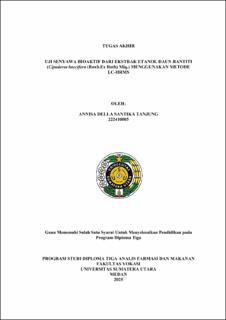Uji Senyawa Bioaktif dari Ekstrak Etanol Daun Rantiti (Cipadessa baccifera (Roxb.Ex Roth) Miq.) Menggunakan Metode LC-HRMS
Test of Bioactive Compounds from Ethanol Extract of Rantiti Leaves (Cipadessa baccifera (Roxb.Ex Roth) Miq.) Using LC-HRMS Method

Date
2025Author
Santika Tanjung, Annisa Della
Advisor(s)
Cintya, Henni
Metadata
Show full item recordAbstract
Background: Rantiti (Cipadessa baccifera (Roxb.Ex Roth) Miq.), is known locally as rantiti leaves. This plant belongs to the Meliaceae family and is traditionally used to treat various health disorders. The Liquid Chromatography–High Resolution Mass Spectrometry (LC-HRMS) method is an effective technique for identifying secondary metabolites in plant extracts accurately and sensitively.
Objective: The aim of this study was to identify and characterize the bioactive compounds contained in the extract of rantiti leaves (Cipadessa baccifera (Roxb.Ex Roth) Miq.) using the Liquid Chromatography–High Resolution Mass Spectrometry (LC-HRMS) method.
Benefits: This research is useful as a source of initial data regarding bioactive compounds in the leaves of Cipadessa baccifera (Roxb.Ex Roth) Miq. which have the potential to be developed as herbal medicine ingredients or products.
Methods: This research was conducted with an exploratory approach to identify bioactive compounds in the leaves of Cipadessa baccifera (Roxb.Ex Roth) Miq. The ethanol extract was analyzed using a Liquid Chromatography–High Resolution Mass Spectrometry (LC-HRMS) instrument to determine the profile of secondary metabolites. The results of the compound analysis were confirmed by matching against a natural compound database to identify their potential bioactivity.
Results: The yield of ethanol extract of rantiti leaves was 20.74%. The results of LC-HRMS analysis of the ethanol extract of leaves (Cipadessa baccifera (Roxb.Ex Roth) Miq.) successfully identified 840 secondary metabolite compounds.
Conclusion: Based on the results of analysis using LC-HRMS, the ethanol extract of leaves is (Cipadessa baccifera (Roxb.Ex Roth) Miq. contains various secondary metabolite compounds.
Collections
- Diploma Papers [78]
